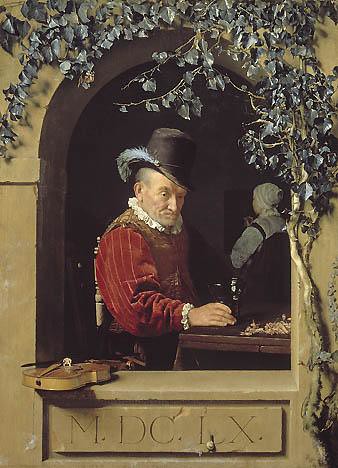Cross-reference with "Things You Can Learn From Other Mediums"
So, on the aforementioned emergency trip back to Boston, I went with my parents to the Peabody Essex Museum in Salem. My family is extremely Dutch (my father is 100%, so I'm a good solid half), and my parents just visited the Netherlands last fall, so they had great fun running around looking at the famous old buildings in the paintings, and indicating which ones they saw.
The Netherlands is well-represented at the Peabody Essex Museum, as Salem is a port city, they emphasize trade and maritime art, and the Netherlands is famous for the Dutch East India Trading company, which dominated the seas and ports for almost two centuries.
As it happens, I've been taking art class lately to improve my skills; it's important for a designer to create sketches that are both accurate and compelling, so that the entire production team understands and is on the same page. One recommendation made to me was to study the masters, so I had great fun bouncing around the exhibit and making erudite art student comments. I managed to track down a couple images I found interesting, and here's some of the thoughts I had on them.

Still Life with Roses in a Glass Vase, c. 1619 by Ambrosius Bosschaert the Elder
The placard on this painting pointed out the fact that none of these flowers were in season at the same time, so artists would sketch them all separately. While my father pointed out the cast shadow of the arrangement onto the stone archway, I noticed that the shadow doesn't really wrap around the figure itself (this is something we've been working on in my class). The light is obviously coming from the left, but the flowers on the right side don't seem obviously darker, or shaded from the light by the other flowers.
 |
| Still Life With Glasses and Tobacco, 1633 by Willem Claesz. Heda |
 |
| Sleeping Dog, 1650 by Gerrit Dou |
Anyway, I thought it was really interesting that in any group paintings--family portraits, crowd scenes, etc.--there was always a dog. As my roommate pointed out, it was a sign of wealth to have a dog, so you wanted to make sure yours was included in a picture of your family. Or, in a more fictional scene, it was a good way to help indicate the social standing of the characters involved.
 |
| Frans van Mieris the Elder’s “The Old Violinist" |
There are so many other examples from this exhibit I could cite- and maybe ones that are more relevant to theatre. I certainly saw several paintings that were great examples of fashion history, or composition, or capturing a dramatic tableau. But these were the pieces that really piqued my interest.
A few other things I noted from the experience of going to a popular exhibit at a gallery:
If you are a very old lady, it is apparently okay to bump into someone, touch their butt, and not apologize.
If you have children, know what types of entertainment will interest them, and what their limitations are. Some kids can behave themselves really well, and will get a lot out of a gallery. Others will try to touch 400 year old furniture.
A "tronie" is a Dutch term for a kind of portrait where the expression or costuming elements are more important than the accuracy of the likeness. There were several very interesting examples of this type of work, but the group behind me were more amused by suggesting what cosmetic treatments the lady in the painting might benefit from.
I guess you need to know the maturity level of your adults as well as your kids.
No comments:
Post a Comment